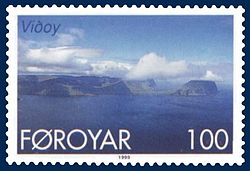Viðoy
Viðoy | |
|---|---|
 Stamp FR 349 of Postverk Føroya (issued: 25 May 1999; photo: Per á Hædd) | |
 Location within the Faroe Islands | |
| State | |
| Constituent country | |
| Municipality seat | Viðareiði |
| Area | |
| • Total | 41 km2 (16 sq mi) |
| • Rank | 7 |
| Highest elevation | 841 m (2,759 ft) |
| Population (2002) | |
| • Total | 617 |
| • Rank | 7 |
| • Density | 15/km2 (39/sq mi) |
| Time zone | UTC+0 (GMT) |
| • Summer (DST) | UTC+1 (EST) |
| Calling code | 298 |
Viðoy (Danish: Viderø) is the northern-most island in the Faroe Islands, located east of Borðoy to which it is linked via a causeway. The name means wood island, despite the fact that no trees grow on the island: the name relates to the driftwood that floats in from Siberia and North America.
Geography
The island has two settlements: Hvannasund on the south-west coast and Viðareiði on the north-west coast, the northernmost settlement in the Faroes. A road along the west coast of the island connects the two. The island is connected by a road causeway to Norðdepil on Borðoy and a bus service from Klaksvík runs across the causeway to the island.[1]
Important Bird Area
The island’s northern and eastern coast has been identified as an Important Bird Area by BirdLife International because of its significance as a breeding site for seabirds, especially European Storm Petrels (500 pairs), Black-legged Kittiwakes (5300 pairs), Atlantic Puffins (25,000 pairs), Common Guillemots (6700 individuals) and Black Guillemots (200 pairs).[2]
Mountains

Viðoy has eleven mountains of which Villingadalsfjall is the northern-most peak in the Faroes. The north coast also has the Enniberg cliff, which at 750 m is the second highest sea-cliff in Europe (after Hornelen, in Norway). The mountains are shown with their overall rank in the Faroe Islands:[3]
| Rank | Name | Height |
|---|---|---|
| 3 | Villingadalsfjall | 841m |
| 24 | Nakkurin (norðari) | 754m |
| 29 | Malinsfjall | 750m |
| 52 | Filthatturin | 688m |
| 53 | Oyggjarskoratindur | 687m |
| 67 | Enniberg | 651m |
| 84 | Sneis | 634m |
| 116 | Tunnafjall | 593m |
| 147 | Talvborð | 557m |
| 174 | Mølin | 511m |
| 192 | Nakkurin | 481m |
References
- ^ Swaney, Deanna (June 1999) [1991]. Iceland, Greenland & the Faroe Islands (3rd edition ed.). Lonely Planet Publications. ISBN 0-86442-453-1.
{{cite book}}:|edition=has extra text (help); Check date values in:|year=/|date=mismatch (help); Cite has empty unknown parameter:|unused_data=(help); Unknown parameter|origmonth=ignored (help) - ^ BirdLife International. (2012). Important Bird Areas factsheet: Vidoy. Downloaded from http://www.birdlife.org on 2012-02-24.
- ^ List of mountains of the Faroe Islands
External links
- Personal website with 6 aerial photos of Viðoy

